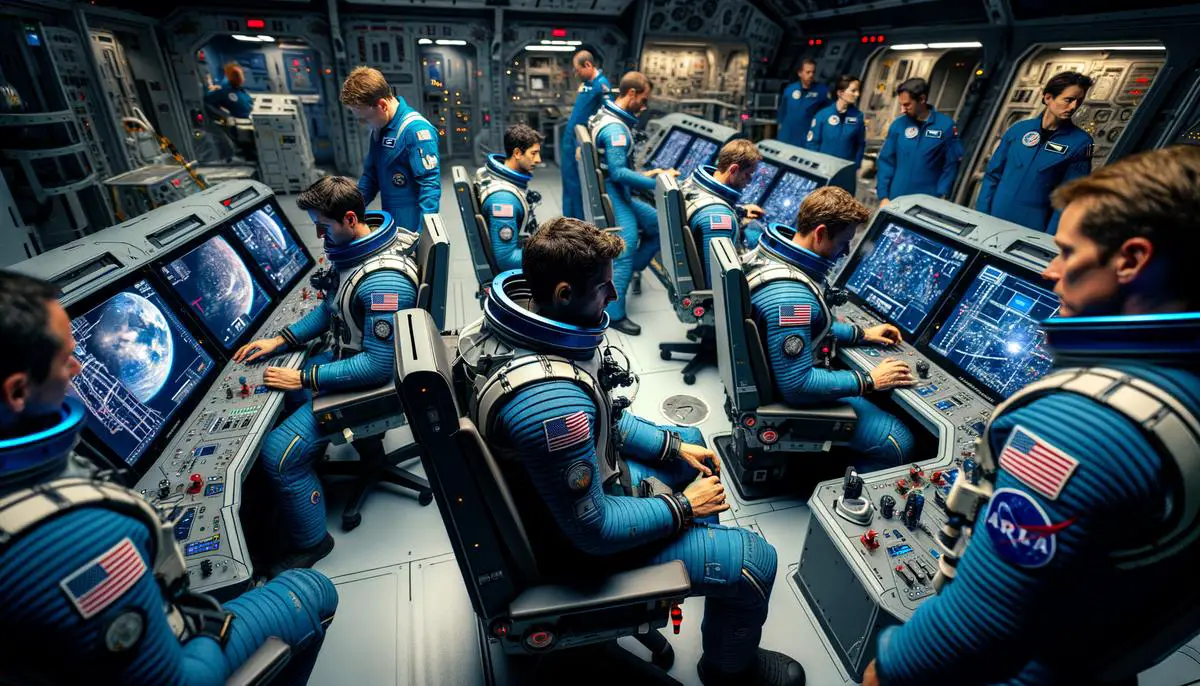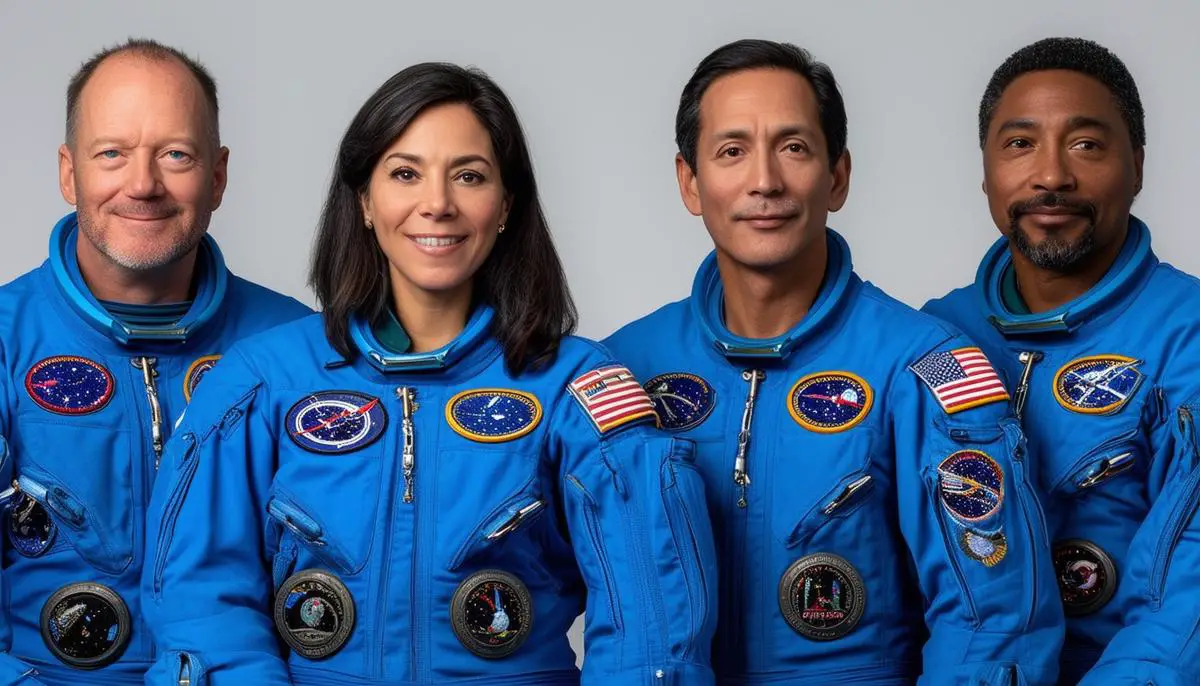Contents
Diverse Backgrounds
The Artemis program marks a new era in space exploration, featuring a lineup of astronauts from diverse backgrounds. Each astronaut's unique qualifications contribute to the program's depth and potential.
Christina Koch, an electrical engineer, has experience with Earth's extreme environments and holds the record for the longest single spaceflight by a woman. Her endurance and engineering knowledge prepare her well for lunar expeditions. Jessica Meir, another astronaut, studied animal physiology under extreme conditions, making her suited to understanding life's sustenance in space.
Victor Glover, who piloted SpaceX's Crew Dragon, brings extensive flight experience to the team. His piloting skills under challenging conditions highlight his potential contributions to spacecraft dynamics during Artemis missions.
Kayla Barron, a systems engineer and former U.S. Navy submarine warfare officer, represents a stride towards inclusive representation in space exploration. Her engineering expertise and leadership experience in high-pressure environments translate to problem-solving and decision-making skills in space.
Anne McClain commands aerospace engineering experience and expertise from her military service, having flown over 2,000 hours in 20 different aircraft. Her adaptability and resourcefulness are essential for the unpredictability of space travel.
The Artemis Team also includes international collaboration with Jeremy Hansen of the Canadian Space Agency. As a fighter pilot and astronaut trainer, he brings valuable interdisciplinary and multi-national insights to the mission.
Astronauts like Jasmin Moghbeli, who piloted combat missions and studied aerospace engineering and IT, epitomize the integration of tactical experience with advanced technical knowledge. This combination is crucial for the technically sophisticated and physically demanding tasks expected on lunar missions.
The diverse core of astronauts promotes richer problem-solving and social inclusion, paving a path back to the moon and potentially to Mars. Artemis symbolizes a stride toward conquering new space frontiers and celebrating human potential.
Historic Milestones
Artemis II aims to break new ground with its astronauts who are set to make history. Christina Koch and Jessica Meir previously conducted the first all-female spacewalk, showcasing their talent and tenacity outside the International Space Station.
Christina Koch also achieved the longest single spaceflight by a woman, spanning 328 days. This record challenged physical and psychological paradigms and demonstrated remarkable resilience in space.
The inclusion of Canadian astronaut Jeremy Hansen in Artemis II is another milestone, as he will be the first Canadian to fly beyond Earth's orbit. This exemplifies international cooperation and shared lunar ambitions across borders.
As Artemis II looks beyond the moon, these milestones reflect the possibilities of unprecedented exploration and the ongoing quest for knowledge and unity in the vast universe. The mission contributes to the broader narrative of human endeavor, charting a pathway back to the lunar surface and potentially to Mars.
Mission Roles and Responsibilities
Within the Artemis II mission, each role is vital to its success, leveraging the individual strengths of the team members. Commander Reid Wiseman serves as the mission leader, orchestrating critical phases, communicating with NASA's mission control, and making pivotal decisions. His seasoned judgment ensures the mission remains aligned with its goals.
Victor Glover, the Pilot, supports navigation and spacecraft operations. His adeptness with cutting-edge aerospace technology is crucial in ensuring the Orion spacecraft follows its trajectory and maintains optimal performance.
The mission specialists, Christina Koch and Jeremy Hansen, handle specialized tasks onboard. Christina Koch, as Mission Specialist 1, manages scientific experiments and the spacecraft's life-support system. Her track record on the ISS, where she conducted numerous scientific tasks, prepares her for this role.
Jeremy Hansen, Mission Specialist 2, is responsible for operational management during spacewalks and serves as a bridge for technical and scientific communication between Earth and Artemis II. His role transcends operations to sustain international collaborative ties.
These roles form a cohesive unit capable of addressing the challenges of space exploration. They connect individual excellence to shared mission objectives, reflecting the collaborative spirit aimed at extending human presence in the cosmos.
Training and Preparation
The astronauts of Artemis II undergo rigorous training to equip them with the necessary skills for the challenges of space travel. Preparation for the mission is both physically and intellectually demanding, encompassing simulations, physical training, and specialized education.
Simulation-based training is a cornerstone of their preparation. Astronauts engage in simulations that recreate scenarios they might face in space, from standard procedures to emergency responses. These simulations are conducted in replicated spacecraft environments and utilize virtual reality technology to immerse astronauts in the extraterrestrial setting.
Physical fitness is paramount, given the strains of extended periods in microgravity. Each astronaut follows a customized training regimen to enhance strength, stamina, and flexibility. Workouts include:
- Resistance training
- Cardiovascular exercises
- Balance training to maintain health and orient themselves in weightlessness
Specialized education also plays a vital role. Astronauts explore geological and biological studies to conduct meaningful research on the moon. They study the lunar surface terrain to prepare for landing, launching, and surface exploration activities.
Mental readiness is a significant aspect of their training. Astronauts participate in isolation exercises simulating the confined environment of space. Workshops focus on team dynamics and conflict resolution to maintain psychological health and team synergy during the mission.
This extensive training ensures that the Artemis II team is well-prepared and resilient. Sharpened by simulations, fortified through physical conditioning, and enriched with specialized learning, these astronauts are ready to take on the challenges of lunar exploration with expertise and confidence.

Future Goals and Implications
Artemis II paves the way for a more sustainable human presence on the moon. The broader vision of the Artemis program extends to the creation of a permanent lunar outpost, serving as a springboard for future missions to Mars and beyond.
Establishing a lasting human habitation on the lunar surface involves developing infrastructure, including habitats, research facilities, and potential industrial setups utilizing lunar resources. This transforms the moon from an object of exploration to a hub of sustained scientific activity and technological advancement.
Exploring beyond Earth's satellite, Artemis is a vital preparatory stage for long-duration spaceflight and eventual missions to Mars. The skills, technologies, and collaborations developed through Artemis missions are invaluable stepping stones for future interplanetary endeavors.
Artemis also communicates influential shifts in human spaceflight operations and geopolitical boundaries. By undertaking shared lunar missions with international partners and collaborating with the private sector, Artemis fosters a dynamic ecosystem of space exploration. Embedding an international crew in missions like Artemis II promotes global stakeholding and integrates diverse technological and cultural insights.
The spin-offs from fostering a resource-driven, multi-national venture on the moon have direct terrestrial benefits, from mining energy alternatives to piloting remote operational technologies. The technology harnessed for space exploration leads to sophisticated Earth-bound applications, and exploratory accomplishments seed ground-breaking innovations.
As activities under the Artemis program unfold, they shape a legacy of sustained interstellar humanity. From cooperative efforts in building a moon base to the logistics of sustaining life on Mars, the implications of these interconnected objectives define the technological challenges and celebrate global unity in venturing into the great unknown.
- Koch C, Meir J, Glover V, Barron K, McClain A, Hansen J. The Artemis Team: Astronaut Profiles. NASA. 2023.
- Wiseman R. Artemis II Mission Overview. NASA. 2023.
- Hansen J. Canadian Space Agency Collaboration in Artemis. CSA. 2023.
- Moghbeli J. Integrating Tactical Experience with Technical Knowledge for Lunar Missions. NASA. 2023.
- Artemis: NASA's Lunar Exploration Program Overview. NASA. 2023.
